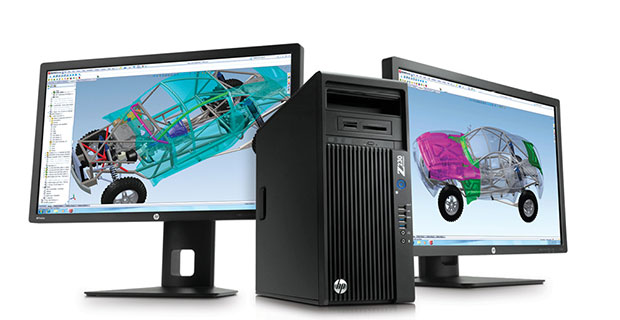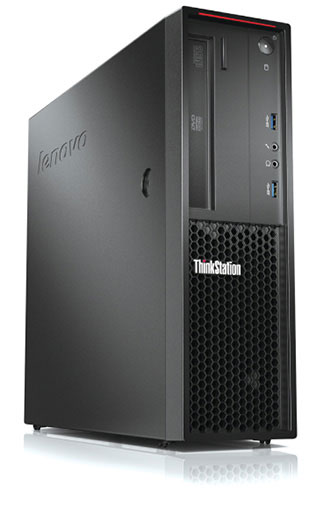Professional Machines at Consumer Pricing?

Prices for HP’s Z230 entry-level workstation, shown here in tower format, begin at $799.
May 1, 2015
Workstations are more expensive than consumer PCs — that’s the general assumption among hardware buyers. The former is specifically designed for professionals, running 3D applications used in automotive manufacturing, aeronautic engineering and commercial building projects. The latter is for balancing checkbooks in Excel, editing family photos and typing up résumés. The price difference reflects the disparity in performance between the two classes of machines. So some budget-conscious buyers come up with what seems like an ingenious strategy: Buy a decent consumer PC, spend some extra on CPU, GPU (graphics processing unit) or RAM upgrades and use it to run CAD applications. Even though hardware makers discourage it and software vendors don’t sanction it, the truth is, you can do it.
You can, but you don’t have to. Five or six years ago, the price gap between a workstation and a consumer PC was significant, so the approach was understandable. But today, with the availability of sub-$1,000 workstations, the practice no longer makes economic sense. Lenovo’s ThinkStation P series entry-level workstations begin at $656. Dell’s entry-level workstation, the Dell Precision T1700, begins at $679. HP’s Z230, starts at $799. These prices are well within the range of consumers who might consider the Lenovo IdeaCenter K450 performance desktop ($679 at Best Buy online) or the HP ENVY 700 desktops (beginning from $749 at HP online). The ideal professional hardware has become as affordable as the compromise. Therefore, the previous cost-benefit equation should be, at the very least, revisited.
High-end PC vs. Entry-level Workstation
If there’s no difference in price, what are the differences between entry-level workstations and consumer PCs? Plenty, according to computer and engineering software vendors.
“A surgeon doesn’t wake up in the morning and pick up a kitchen knife and go to work to perform brain surgery. They use a scalpel. The two things are both knives, but one is a professional tool for a professional job,” says Andy Rhodes, executive director of Dell Precision workstations. (For more on this, read the white paper titled “Making the Case for Professional Engineering Workstations”).
Even high-end consumer systems are not ideal for professional engineering work, according to Richard Runnells, director of Marketing for Solid Edge at Siemens PLM Software.
“While in some instances using a high-end consumer PC or even a gaming PC may work to meet the minimum requirements for desktop CAD applications, typically these systems are maxed out and provide little to no room for future expansion,” he says. “The cost of an entry-level workstation, which comes pre-configured and certified to run CAD applications, such as Solid Edge, is in many cases lower in price than that of a top-of-the-line gaming PC.”
HP’s Jeff Wood, vice president of Product Management for Workstation & Thin Client Business at HP, agrees with Runnells’ conclusions.
“Buyers are missing a huge benefit in productivity when they opt for the consumer PC, certainly versus our Z workstations,” he says. “The workstations have been highly tuned for professional applications. Another consideration is [that] many of the CAD software vendors are unwilling to provide software support for non-certified consumer PCs.”
That’s because certification is a rigorous process that involves hardware and software vendors working together to find and solve any compatibility issue before the workstation is released.
“Independent Software Vendor (ISV) certification ensures the system is qualified and supported by the ISV for workstation software applications,” says Al Makley, director of ThinkStation Architecture and Technical Solutions, Lenovo. “Desktop PCs do not have ISV certification.”
In some workstations, utilities that cater to the professional software user base enhance the experience. “With Dell Precision Optimizer, an automated software tool installed on all Dell Precision workstations that fine-tunes your system beyond standard factory settings, professional engineers can achieve the best possible application performance while running software from leading vendors like Autodesk, Dassault Systèmes, PTC and Siemens,” says Rhodes.
“We certify workstation-class graphics cards as part of our hardware certification program,” says Justin Kidder, director of SolidWorks Graphics and Architecture. “What this means is, we know what to expect in terms of graphics drivers and their interactions with the workstation. While some customers may choose to run on consumer or gaming PCs, we do not certify them for use with SolidWorks, and do not recommend that our customers do this.”
Even if the software vendor is willing overlook the unsanctioned use of a consumer PC and gaming graphics, the resources available may be limited. “Autodesk doesn’t recommend or certify these systems/cards. However, if an engineer encounters a problem with running Autodesk Inventor on one of these configurations, Autodesk will try its best to provide support for that issue. Diagnosis and solutions are frequently dependent on us having the configuration available as well as a vendor’s willingness to support a potential problem within their driver/hardware,” says Tom Rang, senior quality assurance manager at Autodesk.
Processor and Graphics
Geometry editing, the core function of CAD, is primarily CPU-driven. Most mainstream CAD vendors are making efforts to parallelize their CAD so the software can take advantage of more than one CPU, but they have succeeded only to a limited extent. Therefore, despite widespread availability of workstations with multiple CPUs, a single fast CPU remains the best configuration CAD users.
“We recommend a fast single CPU and, if your budget allows, multiple fast CPUs. There’s a slight benefit using multiple processor/core machines, but only for certain operations within Autodesk Inventor (e.g. 3D view manipulation, like panning, zooming, and rotation; ray tracing; Inventor Studio rendering; mass property computation; and 3D faceting),” says Rang.
Mainstream CAD packages usually offer built-in rendering and visualization tools. Some of these tools may benefit from the GPU’s massively parallel processing power; however, the degree of GPU acceleration possible varies. SolidWorks, for example, comes with PhotoView for rendering 3D models into photorealistic imagery. But it relies on the CPU only and doesn’t benefit from GPU acceleration. By contrast, an independent rendering program like Bunkspeed SHOT is designed to tap into the GPU’s horsepower.
“We recommended you use a graphics card with a minimum of 1GB of memory or more. It’s important that the card support DirectX11 if running Autodesk Inventor 2015 or newer. Most Inventor graphic features are implemented based on DirectX11 APIs (application programming interfaces),” says Rang.
“CAD and CAE applications typically don’t tax the graphics sub-system much, unless they are utilizing 3D rendering for fly-through,” says HP’s Wood. Such usage would go beyond typical CAD rendering; it’s much closer to the type of visualization done in specialized animation and rendering programs like Autodesk 3ds Max.
If you work primarily in design programs that benefit from GPU acceleration, your choice should be a professional graphics card certified for your preferred CAD program. They tend to offer certain advantages over uncertified gaming or consumer graphics. “Professional-level graphic cards provide additional performance benefits over gaming cards, since they are designed to handle the workloads often encountered while working in a CAD environment,” says Runnells.
Memory and Hard Disk
For CAD users who must open, edit, tumble and rotate large assembly files, a generous memory allocation is essential. If the system’s random access memory (RAM) is insufficient to accommodate the size of the assembly model, the system must tap into the hard disk itself to “borrow” space. This process is often the culprit in decreased software performance.
“Memory is the most important factor to consider when it comes to Autodesk Inventor’s performance. Inventor requires a minimum of 8GB; 12GB is recommended. The more RAM installed in the machine, the better the performance a user will experience, particularly when designing very complex components and/or working with large assembly datasets. Consult the specifications of the computer’s motherboard to understand how much RAM it supports and be sure to invest in faster RAM chip sets,” says Rang.
“You can never go wrong with too much memory. Prices have come down to the point where you can buy more RAM than you’ll ever think you’ll need, and you’ll still find a way to use it,” says SolidWorks’ Kidder.
Most workstation vendors offer both traditional hard drives and solid-state drives (SSD) in the configuration options. Experts tend to advocate SSD, for the advantage it offers in data reading, writing, and retrieval speed. “Make sure you have at least one SSD in your workstation. The performance boost you’ll see when loading and saving files will be worth it,” says Kidder.
Virtualization and Workstations
One alternative previously unavailable for CAD users is remote desktops or virtual machines. Server-hosted workstations have always been around as on-premise solutions, but remote access to the workstation (for example, accessing the workstation from a client’s site using a lightweight laptop or tablet) was hampered by bandwidth issues and the limitation of virtualization technologies. But in the last few years, virtualization has made great strides, spearheaded by Citrix, VMWare and NVIDIA. (The GPU maker offers NVIDIA GRID appliances for hosting virtual machines, each allocated with its own virtual GPU.) This has given birth to Desktop-as-a-Service (DaaS) vendors, offering virtual machines hosted in the private or public cloud, delivered on-demand to users. The business model could compete with traditional workstations.
“Investment in on-premise virtualization can be cost prohibitive for smaller businesses without dedicated IT services. Utilizing on-demand virtual solutions can be an advantage for these businesses, but many are still concerned about data security and integrity. Most businesses will continue to deploy discrete workstation solutions under the desk until the industry is ready to provide a secure solution at a competitive cost,” says Wood.
Lenovo’s Makley agrees.
“Depending on the size of the customer and the workload required, entry-level workstation may still provide a better return on investment than remote (virtualized) workstation deployment,” he says. “Data security and remote collaboration are the leading factors that drive professionals to remote (virtualized) workstation deployment. As remote (virtualized) workstation capabilities increase, we may see an offload of traditional high-end workstation requirements (design visualization, rendering, simulation) to the data center, leading to more entry-level workstations at the professional’s desk.”
Gary Radburn, head of workstation virtualization at Dell, says the company thinks of virtualization as extending the reach of a workstation, rather than as a replacement.
“Some companies may want to implement centralized control, centralized manageability, and have a flexible working policy [facilitated by virtual machines]; however, there will also be those who have not considered workstations before or have not had the opportunity to experience their value firsthand, but who can now implement fully certified, virtualized systems,” he says.
While the cost differences between consumer PCs and entry-level professional workstations have disappeared, the line between virtual and physical hardware is still blurring. It’s not clear whether entry-level workstations will eventually give way to virtualization, or whether the two will continue to co-exist by fulfilling different users’ needs. What is clear is that engineering teams have more choices than ever when it comes to professional, workstation-class computing.
More Info
Subscribe to our FREE magazine, FREE email newsletters or both!
About the Author
Kenneth Wong is Digital Engineering’s resident blogger and senior editor. Email him at [email protected] or share your thoughts on this article at digitaleng.news/facebook.
Follow DE







